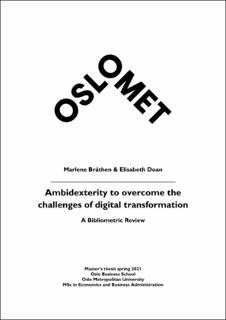| dc.description.abstract | Digital transformation is a complex process, and many organisations fail in their endeavours.
Extant research presents different aspects that organisations struggle with within their digital
transformation process. Some researchers state that external drivers such as digital
technology, digital competition, and digital customer behaviour can influence the digital
transformation process. In contrast, other researchers express that it can be challenging to
succeed with the digital transformation as it affects the internal operational processes,
business models and customer experiences. However, a common feature of the extant
literature is that substantial research addresses innovation, learning and change in
organisations. The reason why such topics are addressed in the literature can be explained
by the fact that digital transformation constitutes a technological change and an organisational
one. As external conditions, such as technology, are increasingly varied, learning and
adapting to environmental changes is becoming more critical. Organisational ambidexterity,
the ability to simultaneously handle explorative and exploitative learning, has by extant
research been suggested as a potential strategy to foster organisational ability to maintain
daily business concerns while continuously changing to tomorrow’s business needs.
As surprisingly little research addresses how these two learning modes are involved in
achieving digital transformation, this thesis offers a systematic literature review aided by
bibliometric analysis to provide a conceptual bridge between extant research on
organisational ambidexterity and digital transformation. We based our analysis on an
exhaustive search of published academic literature conducted in the Web of Science (WoS)
database, which resulted in 1 338 identified articles. After conducting an exclusion process
based on given subjective and objective criteria, we were left with 279 papers. We further
narrowed it down to 141 articles using bibliometric coupling to ensure thematic relevance. A
content analysis of these 141 papers helped us identify nine core articles that linked
organisational ambidexterity to digital transformation. Based on the review of extant research,
we identified three dimensions (i.e. internal orientation, external orientation, and structural
integration), consisting of nine different learning considerations necessary to manage digital
transformation. We subsequently offer four propositions and a Venn diagram that both provide
a foundation for further research and practice. | en_US |
